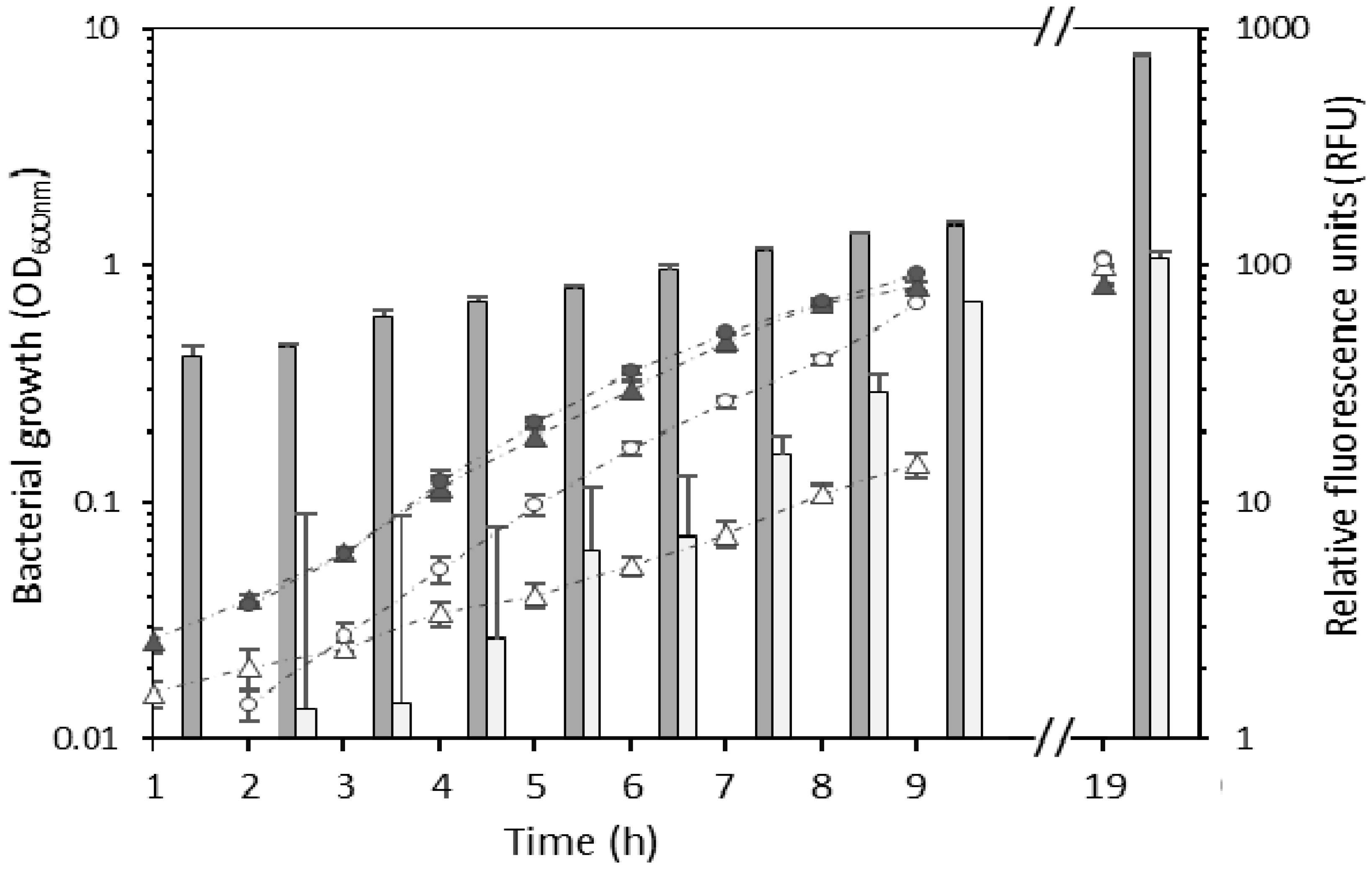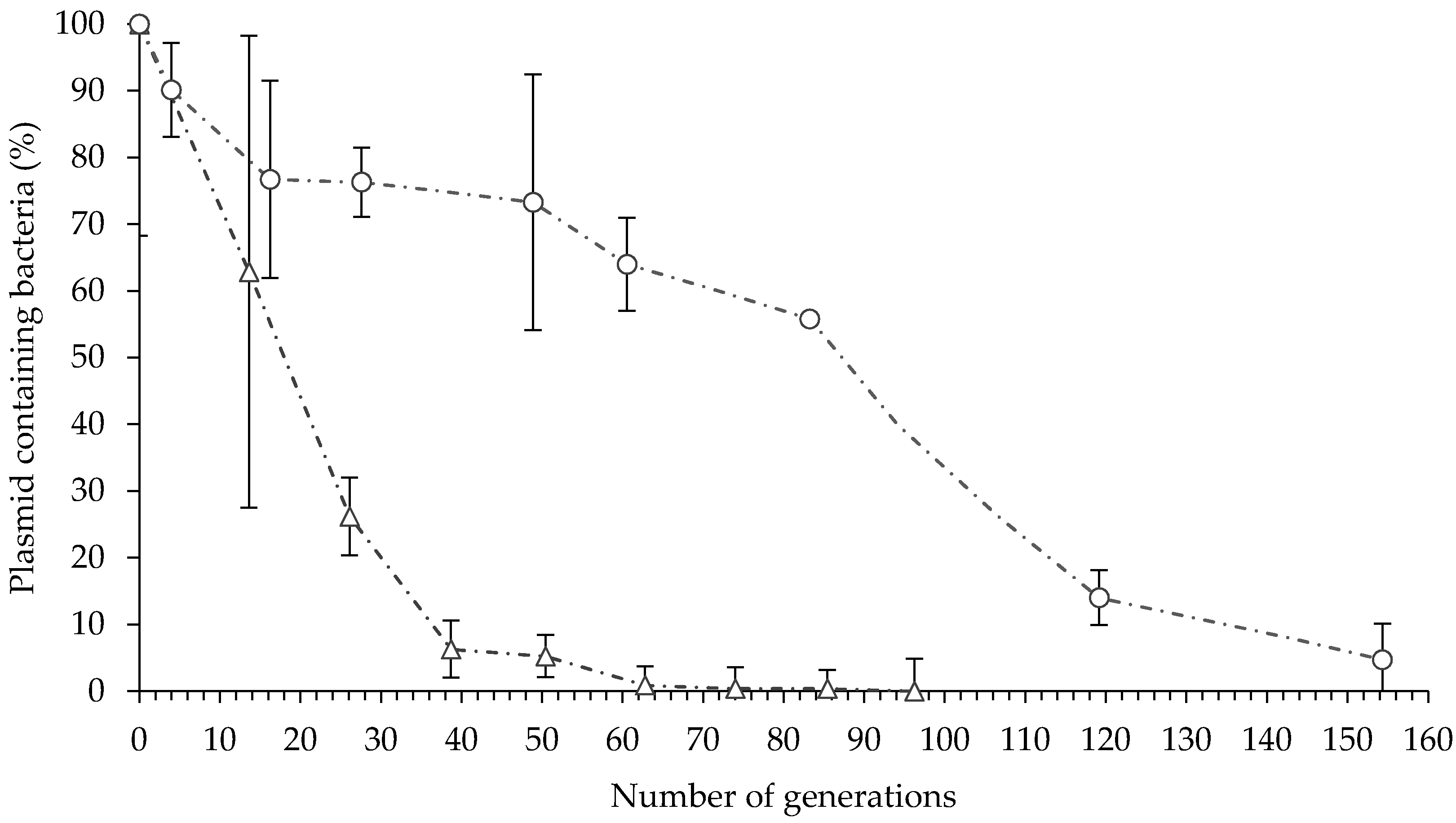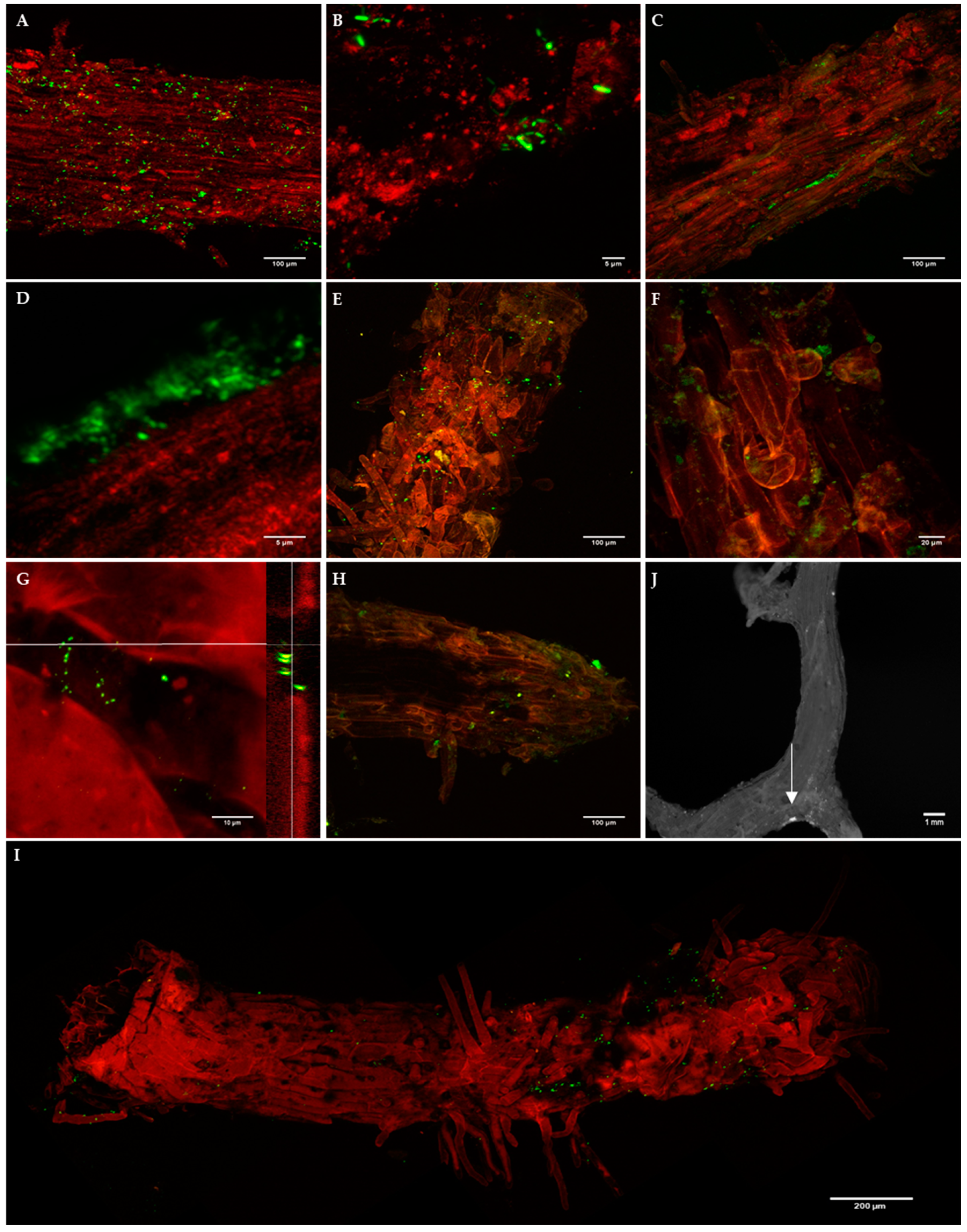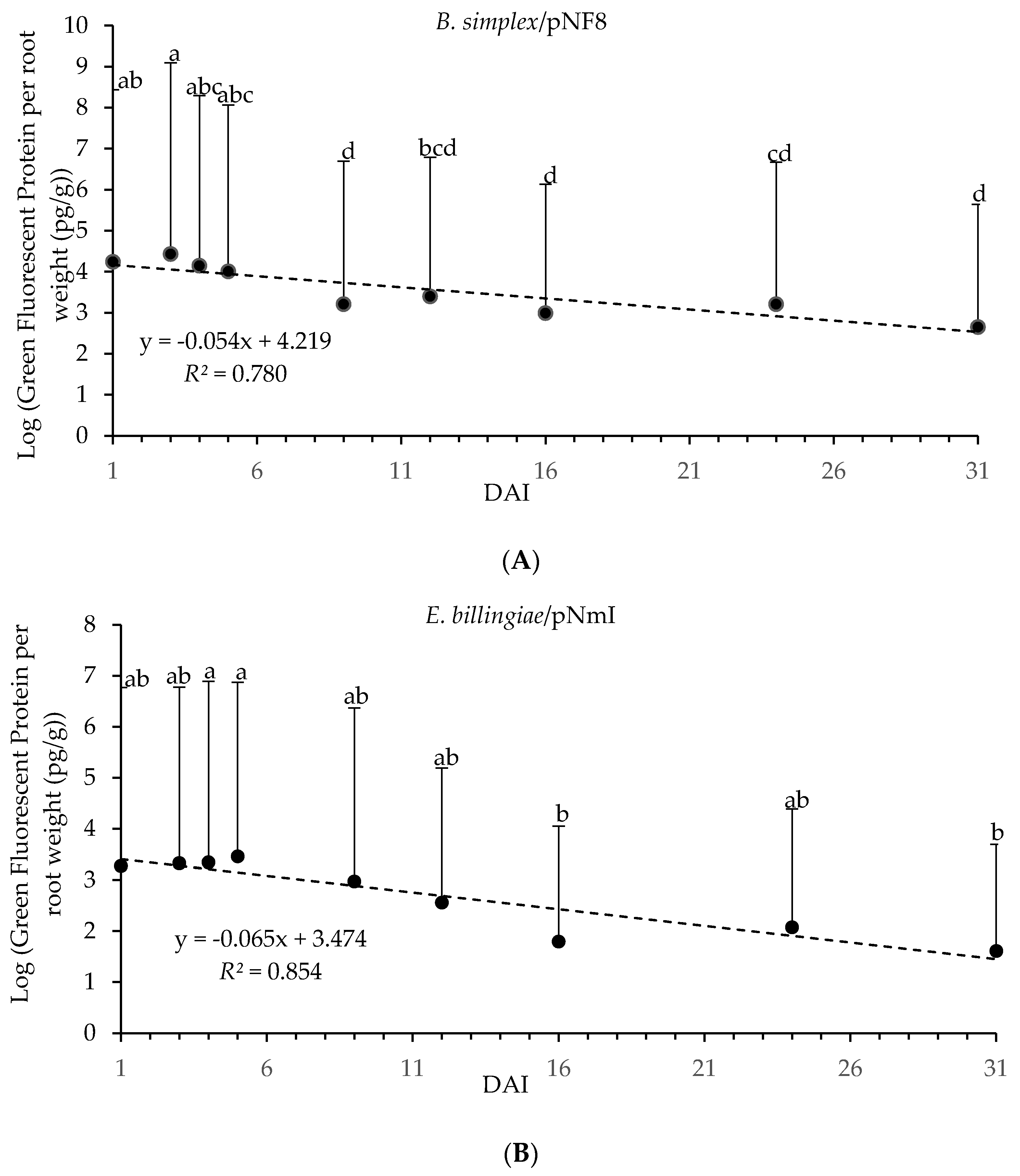Colonization of Pinus radiata D. Don Seedling Roots by Biocontrol Bacteria Erwinia billingiae and Bacillus simplex
Abstract
:1. Introduction
2. Materials and Methods
2.1. Bacterial Strains and Plasmids
2.2. Plasmid Construction and Transformation of Biocontrol Bacterial Strains
2.3. Determination of Bacterial Generation Time and Plasmid Stability In Vitro
2.4. Determination of Bacterial Colonization Patterns on P. radiata Seedling Roots
3. Results
3.1. Bacterial Generation Time and Plasmid Stability
3.2. Bacterial Colonization Patterns on P. radiata Seedling Roots
4. Discussion
5. Conclusions
Author Contributions
Funding
Acknowledgments
Conflicts of Interest
References
- Mead, D.J. Sustainable Management of Pinus radiata Plantations; FAO Forestry Paper No. 170; FAO: Rome, Italy, 2013. [Google Scholar]
- HAZI. El Bosque Vasco en Cifras. Available online: http://www.nasdap.ejgv.euskadi.eus/contenidos/informacion/inventario_forestal_2011/es_agripes/adjuntos/El%20bosque%20vasco%20en%20cifras%202011_2012.pdf (accessed on 29 May 2019).
- Murua, J.R.; Albiac, J.; Astorkiza, I.; Eguía, B.; Ferrero, A.; Moreno, J. Libro Blanco del Sector de la Madera: Actividad Forestal e Industria de Transformación de la Madera: Evolución Reciente y Perspectivas en Euskadi, 1st ed.; Eusko Jaurlaritzaren Argitalpen Zerbitzu Nagusia: Vitoria-Gasteiz, Spain, 2016. [Google Scholar]
- MacKenzie, M. Infection changes and volume loss in a 19-year-old Pinus radiata stand affected by Armillaria root rot. N. Z. J. For. Res. 1987, 17, 100–108. [Google Scholar]
- Hood, I.A.; Sandberg, C.J. Armillaria populations in a Pinus radiata plantation on a former indigenous rainforest site. N. Z. J. For. Sci. 1993, 23, 62–77. [Google Scholar]
- Mesanza, N.; Iturritxa, E. Root and butt rot caused by Heterobasidion annosum in atlantic coniferous ecosystems of Spain. For. Pathol. 2012, 42, 514–520. [Google Scholar] [CrossRef]
- Doğmuş-Lehtijärvi, H.T.; Erdoğan, R.C.; Lehtijärvi, A.; Woodward, S.; Aday Kaya, A.G. Pathogenicity of Heterobasidion annosum (Fr.) Bref. sensu stricto on coniferous tree species in Turkey. For. Pathol. 2016, 46, 22–28. [Google Scholar] [CrossRef]
- Mesanza, N.; Patten, C.L.; Iturritxa, E. Distribution and characterization of Armillaria complex in Atlantic forest ecosystems of Spain. Forests 2017, 8, 235. [Google Scholar] [CrossRef]
- Garbelotto, M.; Gonthier, P. Biology, epidemiology, and control of Heterobasidion species worldwide. Annu. Rev. Phytopathol. 2013, 51, 39–59. [Google Scholar] [CrossRef]
- Pratt, J.E.; Lloyd, J.D. The use of disodium octaborate tetrahydrate to control conifer butt rot caused by Heterobasidion annosum. Proc. Crop Prot. North. Br. 1996, 207–212. [Google Scholar]
- Johansson, S.M.; Pratt, J.E.; Asiegbu, F.O. Treatment of Norway spruce and Scots pine stumps with urea against the root and butt rot fungus Heterobasidion annosum-possible modes of action. For. Ecol. Manag. 2002, 157, 87–100. [Google Scholar] [CrossRef]
- Asiegbu, F.O.; Adomas, A.; Stenlid, J. Conifer root and butt rot caused by Heterobasidion annosum (Fr.) Bref. s.l. Mol. Plant Pathol. 2005, 6, 395–409. [Google Scholar] [CrossRef]
- Baumgartner, K.; Coetzee, M.P.A.; Hoffmeister, D. Secrets of the subterranean pathosystem of Armillaria. Mol. Plant Pathol. 2011, 12, 515–534. [Google Scholar] [CrossRef]
- Gonthier, P.; Thor, M. Annosus root and butt rots. In Infectious Forest Diseases; Gonthier, P., Nicolotti, G., Eds.; CAB International: Wallingford, UK, 2013; pp. 128–158. [Google Scholar]
- Shaw III, C.G.; Roth, L.F. Control of Armillaria root rot in managed coniferous forests: A literature review. Eur. J. For. Pathol. 1978, 8, 163–174. [Google Scholar] [CrossRef]
- Mesanza, N.; Iturritxa, E.; Patten, C.L. Native rhizobacteria as biocontrol agents of Heterobasidion annosum s.s. and Armillaria mellea infection of Pinus radiata. Biol. Control 2016, 101, 8–16. [Google Scholar] [CrossRef]
- Lam, S.T.; Ellis, D.M.; Ligon, J.M. Genetic approaches for studying rhizosphere colonisation. Plant Soil 1990, 129, 11–18. [Google Scholar] [CrossRef]
- Chin-A-Woeng, T.F.C.; de Priester, W.; van der Bij, A.J.; Lugtenberg, B.J. Description of the colonization of a gnotobiotic tomato rhizosphere by Pseudomonas fluorescens biocontrol strain WCS365, using scanning electron microscopy. Mol. Plant-Microbe Interact. 1997, 10, 79–86. [Google Scholar] [CrossRef]
- Prieto, P.; Mercado-Blanco, J. Endophytic behaviour of biocontrol strain Pseudomonas fluorescens PICF7 in olive roots using confocal microscopy. FEMS Microbiol Ecol. 2008, 64, 297–306. [Google Scholar] [CrossRef] [PubMed]
- Palacio-Bielsa, A.; Roselló, M.; Llop, P.; López, M.M. Erwinia spp. from pome fruit trees: Similarities and differences among pathogenic and non-pathogenic species. Trees 2012, 26, 13–29. [Google Scholar] [CrossRef]
- Köberl, M.; Ramadan, E.M.; Adam, M.; Cardinale, M.; Hallmann, J.; Heuer, H.; Smalla, K.; Berg, G. Bacillus and Streptomyces were selected as broad-spectrum antagonists against soilborne pathogens from arid areas in Egypt. FEMS Microbiol. Lett. 2013, 342, 168–178. [Google Scholar] [CrossRef] [PubMed]
- Santhanam, R.; Luu, V.T.; Weinhold, A.; Goldberg, J.; Oh, Y.; Baldwin, I.T. Native root-associated bacteria rescue a plant from a sudden-wilt disease that emerged during continuous cropping. Proc. Natl. Acad. Sci. USA 2015, 112, E5013–E5020. [Google Scholar] [CrossRef] [PubMed] [Green Version]
- Yanisch-Perron, C.; Vieira, J.; Messing, J. Improved M13 phage cloning vectors and host strains: Nucleotide sequences of the M13mp18 and pUC19 vectors. Gene 1985, 33, 103–119. [Google Scholar] [CrossRef]
- Keen, N.T.; Tamaki, S.; Kobayashi, D.Y.; Trollinger, D.J. Improved broad-host-range plasmids for DNA cloning in Gram-negative bacteria. Gene 1988, 70, 191–197. [Google Scholar] [CrossRef]
- Weinstein, M.; Roberts, R.C.; Helinski, D.R. A region of the broad-host-range plasmid RK2 causes stable in planta inheritance of plasmids in Rhizobium meliloti cells isolated from alfalfa root nodules. J. Bacteriol. 1992, 174, 7486–7489. [Google Scholar] [CrossRef] [PubMed]
- Kalogeraki, V.S.; Winans, S.C. Suicide plasmids containing promoterless reporter genes can simultaneously disrupt and create fusions to target genes of diverse bacteria. Gene 1997, 188, 69–75. [Google Scholar] [CrossRef]
- Fortineau, N.; Trieu-Cuot, P.; Gaillot, O.; Pellegrini, E.; Berche, P.; Gaillard, J.L. Optimization of green fluorescent protein expression vectors for in vitro and in vivo detection of Listeria monocytogenes. Res. Microbiol. 2000, 151, 353–360. [Google Scholar] [CrossRef]
- Romero, D.; Pérez-García, A.; Veening, J.W.; de Vicente, A.; Kuipers, O.P. Transformation of undomesticated strains of Bacillus subtilis by protoplast electroporation. J. Microbiol. Meth. 2006, 66, 556–559. [Google Scholar] [CrossRef] [PubMed]
- Ma, L.; Zhang, G.; Doyle, M.P. Green Fluorescent Protein Labeling of Listeria, Salmonella, and Escherichia coli O157:H7 for Safety-Related Studies. PLoS ONE 2011, 6, e18083. [Google Scholar] [CrossRef] [PubMed]
- White, D. The Physiology and Biochemistry of Prokaryotes, 3rd ed.; Oxford University Press: New York, NY, USA, 2007. [Google Scholar]
- R Core Team. R: A Language and Environment for Statistical Computing; R Foundation for Statistical Computing: Vienna, Austria, 2015. [Google Scholar]
- Boyd, C.E. Water Quality: An Introduction; Kluwer Academic Publishers: Boston, MA, USA, 2000. [Google Scholar]
- Wenny, D.L.; Dumroese, R.K. Germination of conifer seeds surface sterilized with bleach. Tree Planters’ Notes 1987, 38, 18–21. [Google Scholar]
- Chanway, C.P.; Radley, R.A.; Hall, F.B. Inoculation of conifer seeds with plant growth promoting Bacillus strains causes increased seedlings emergence and biomass. Soil Biol. Biochem. 1991, 23, 575–590. [Google Scholar] [CrossRef]
- Schindelin, J.; Arganda-Carreras, I.; Frise, E. Fiji: An open-source platform for biological-image analysis. Nat. Methods 2012, 9, 676–682. [Google Scholar] [CrossRef] [PubMed]
- Roberts, R.C.; Burioni, R.; Helinski, D.R. Genetic characterization of the stabilizing functions of a region of broad-host-range plasmid RK2. J. Bacteriol. 1990, 172, 6204–6216. [Google Scholar] [CrossRef] [Green Version]
- Sobecky, P.A.; Easter, C.L.; Bear, P.D.; Helinski, D.R. Characterization of the stable maintenance properties of the par region of broad-Host-range plasmid RK2. J. Bacteriol. 1996, 178, 2086–2093. [Google Scholar] [CrossRef]
- Davis, T.L.; Helinski, D.R.; Roberts, R.C. Transcription and autoregulation of the stabilizing functions of broad-host-range plasmid RK2 in Escherichia coli, Agrobacterium tumefaciens, and Pseudomonas aeruginosa. Mol. Microbiol. 1992, 6, 1981–1994. [Google Scholar] [CrossRef]
- Sia, E.A.; Roberts, R.C.; Easter, C.; Helinski, D.R.; Figurski, D.H. Different relative importances of the par operons and the effect of conjugal transfer on the maintenance of intact promiscuous plasmid RK2. J. Bacteriol. 1995, 177, 2789–2797. [Google Scholar] [CrossRef]
- Taté, R.; Riccio, A.; Caputo, E.; Cermola, M.; Favre, R.; Patriarca, E.J. The Rhizobium etli trpB gene is essential for an effective symbiotic interaction with Phaseolus vulgaris. Mol. Plant-Microbe Interact. 1999, 12, 926–933. [Google Scholar] [CrossRef]
- Dombrecht, B.; Vanderleyden, J.; Michiels, J. Stable RK2-derived cloning vectors for the analysis of gene expression and gene function in gram-negative bacteria. Mol. Plant-Microbe Interact. 2001, 14, 426–430. [Google Scholar] [CrossRef]
- Deng, W.L.; Rehm, A.H.; Charkowski, A.O.; Rojas, C.M.; Collmer, A. Pseudomonas syringae exchangeable effector loci: Sequence diversity in representative pathovars and virulence function in P. syringae pv. syringae B728a. J. Bacteriol. 2003, 8, 2592–2602. [Google Scholar] [CrossRef]
- Rincon, A.; Ruiz-Diez, B.; Garcia-Fraile, S.; Garcia, J.A.; Fernandez-Pascual, M.; Pueyo, J.J.; de Felipe, M.R. Colonisation of Pinus halepensis roots by Pseudomonas fluorescens and interaction with the ectomycorrhizal fungus Suillus granulatus. FEMS Microbiol. Ecol. 2005, 51, 303–311. [Google Scholar] [CrossRef]
- Lau, B.T.C.; Malkus, P.; Paulsson, J. New quantitative methods for measuring plasmid loss rates reveal unexpected stability. Plasmid 2013, 70, 353–361. [Google Scholar] [CrossRef] [Green Version]
- Andersen, J.B.; Roldgaard, B.B.; Lindner, A.B.; Christensen, B.B.; Licht, T.R. Construction of a multiple fluorescence labelling system for use in co-invasion studies of Listeria monocytogenes. BMC Microbiol. 2006, 6, 86. [Google Scholar] [CrossRef]
- Artursson, V.; Jansson, J.K. Use of Bromodeoxyuridine Immunocapture To Identify Active Bacteria Associated with Arbuscular Mycorrhizal Hyphae. Appl Environ. Microbiol. 2003, 69, 6208–6215. [Google Scholar] [CrossRef] [Green Version]
- Hassen, A.I.; Labuschagne, N. Root colonization and growth enhancement in wheat and tomato by rhizobacterial isolates from the rhizoplane of grasses. World J. Microbiol. Biotechnol. 2010, 26, 1837–1848. [Google Scholar] [CrossRef]
- Espinosa-Urgel, M.; Kolter, R.; Ramos, J.L. Root colonisation by Pseudomonas putida: Love at first sight. Microbiology 2002, 148, 341–343. [Google Scholar] [CrossRef]
- Bowen, G.D.; Rovira, A.D. Microbial colonization of plant roots. Ann. Rev. Phytopalhol. 1976, 14, 121–144. [Google Scholar] [CrossRef]
- Wensing, A.; Gernold, M.; Geider, K. Detection of Erwinia species from the apple and pear flora by mass spectroscopy of whole cells and with novel PCR primers. J. Appl. Microbiol. 2011, 112, 147–158. [Google Scholar] [CrossRef]
- Gehring, I.; Geider, K. Identification of Erwinia species isolated from apples and pears by differential PCR. J. Microbiol. Methods 2012, 89, 57–62. [Google Scholar] [CrossRef]
- Klein, J.M.; Bennett, R.W.; MacFarland, L.; Abranches Da Silva, M.E.; Meza-Turner, B.M.; Dark, P.M.; Frey, M.E.; Wellappili, D.P.; Beugli, A.D.; Jue, H.J.; et al. Draft genome sequence of Erwinia billingiae OSU19-1, isolated from a pear tree canker. Genome Announc. 2015, 3, e01119-15. [Google Scholar] [CrossRef]
- McEvoy, A.; O’Regan, F.; Fleming, C.C.; Moreland, B.P.; Pollock, J.A.; McGuinness, B.W.; Hodkinson, T.R. Bleeding canker of horse chestnut (Aesculus hippocastanum) in Ireland: Incidence, severity and characterization using DNA sequences and real-time PCR. Plant Pathol. 2016, 65, 1419–1429. [Google Scholar] [CrossRef]
- Nurmiaho-Lassila, E.L.; Timonen, S.; Haahtela, K.; Sen, R. Bacterial colonization patterns of intact Pinus sylvestris mycorrhizospheres in dry pine forest soil: An electron microscopy study. Can. J. Microbiol. 1997, 43, 1017–1035. [Google Scholar] [CrossRef]
- Bent, E.; Breuil, C.; Enebak, S.; Chanway, C.P. Surface colonization of lodgepole pine (Pinus contorta var. latifolia [Dougl. Engelm.]) roots by Pseudomonas fluorescens and Paenibacillus polymyxa under gnotobiotic conditions. Plant Soil 2002, 241, 187–196. [Google Scholar] [CrossRef]
- Erturk, Y.; Ercisli, S.; Cakmakci, R. Yield and growth response of strawberry to plant growth-promoting rhizobacteria inoculation. J. Plant Nutr. 2012, 35, 817–826. [Google Scholar] [CrossRef]
- Urquiza, C.C.; Hernández, I.A.; Medina, J.A.C.; López, M.A.R.; Cruz, J.P.; Zarazúa, R.L.R.; Casas, Z.G.M.; Arteaga, D.L.J.; García, A.A.C.; Pérez, J.C.; et al. Identification by MALDI-TOF mass spectrometry of mercury-resistant bacteria associated with the rhizosphere of an apple orchard. Geomicrobiol. J. 2017, 34, 176–182. [Google Scholar] [CrossRef]
- Akinrinlola, R.J.; Yuen, G.Y.; Drijber, R.A.; Adesemoye, A.O. Evaluation of Bacillus strains for plant growth promotion and predictability of efficacy by in vitro physiological traits. Int. J. Microbiol. 2018, 11. [Google Scholar] [CrossRef]
- Hinsa, S.M.; O’Toole, G.A. Identification and characterization of the LapD protein: LapD modulates the secretion of LapA. Microbiology 2006, 152, 1375–1383. [Google Scholar] [CrossRef]
- Qi, J.; Aiuchi, D.; Tani, M.; Asano, S.; Koike, M. Potential of entomopathogenic Bacillus thuringiensis as plant growth promoting rhizobacteria and biological control agents for tomato Fusarium wilt. IJOEAR 2016, 2, 55–63. [Google Scholar]




| Strain or Plasmid | Relevant Features | Source |
|---|---|---|
| Strains | ||
| E. billingiae S31R1 | Wild-type strain | Reference [16] |
| B. simplex S11R41 | Wild-type strain | Reference [16] |
| E. coli JM109 | Cloning host; endA1, recA1, gyrA96, thiA, hsdR17, relA1, supE44, ∆(lac-proAB), [F′ traD36, proAB+, laqIq lacZ DM15] | Reference [23] |
| Plasmids | ||
| pRK415 | Broad host range expression vector; Tetr | Reference [24] |
| pTR102 | Source of par locus; Tetr | Reference [25] |
| pRK415par | Carries 3.2 kb par locus in pRK415; Tetr | This study |
| pVIK165 | Source of gfp S65T gene; Kanr | Reference [26] |
| pNmI | Carries 774 bp gfp S65T gene in pRK415par; Tetr | This study |
| pNF8 | Expresses gfp mut1; Eryr | Reference [27] |
© 2019 by the authors. Licensee MDPI, Basel, Switzerland. This article is an open access article distributed under the terms and conditions of the Creative Commons Attribution (CC BY) license (http://creativecommons.org/licenses/by/4.0/).
Share and Cite
Mesanza, N.; Crawford, B.D.; Coulson, T.J.D.; Iturritxa, E.; Patten, C.L. Colonization of Pinus radiata D. Don Seedling Roots by Biocontrol Bacteria Erwinia billingiae and Bacillus simplex. Forests 2019, 10, 552. https://doi.org/10.3390/f10070552
Mesanza N, Crawford BD, Coulson TJD, Iturritxa E, Patten CL. Colonization of Pinus radiata D. Don Seedling Roots by Biocontrol Bacteria Erwinia billingiae and Bacillus simplex. Forests. 2019; 10(7):552. https://doi.org/10.3390/f10070552
Chicago/Turabian StyleMesanza, Nebai, Bryan D. Crawford, Thomas J.D. Coulson, Eugenia Iturritxa, and Cheryl L. Patten. 2019. "Colonization of Pinus radiata D. Don Seedling Roots by Biocontrol Bacteria Erwinia billingiae and Bacillus simplex" Forests 10, no. 7: 552. https://doi.org/10.3390/f10070552





